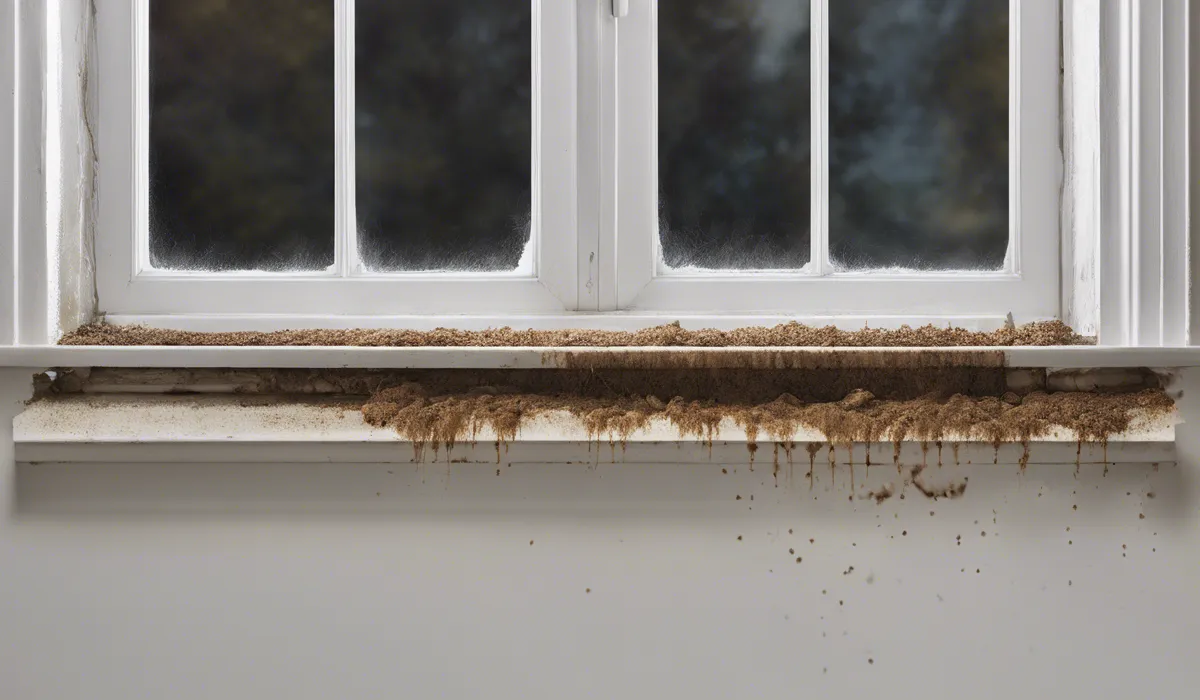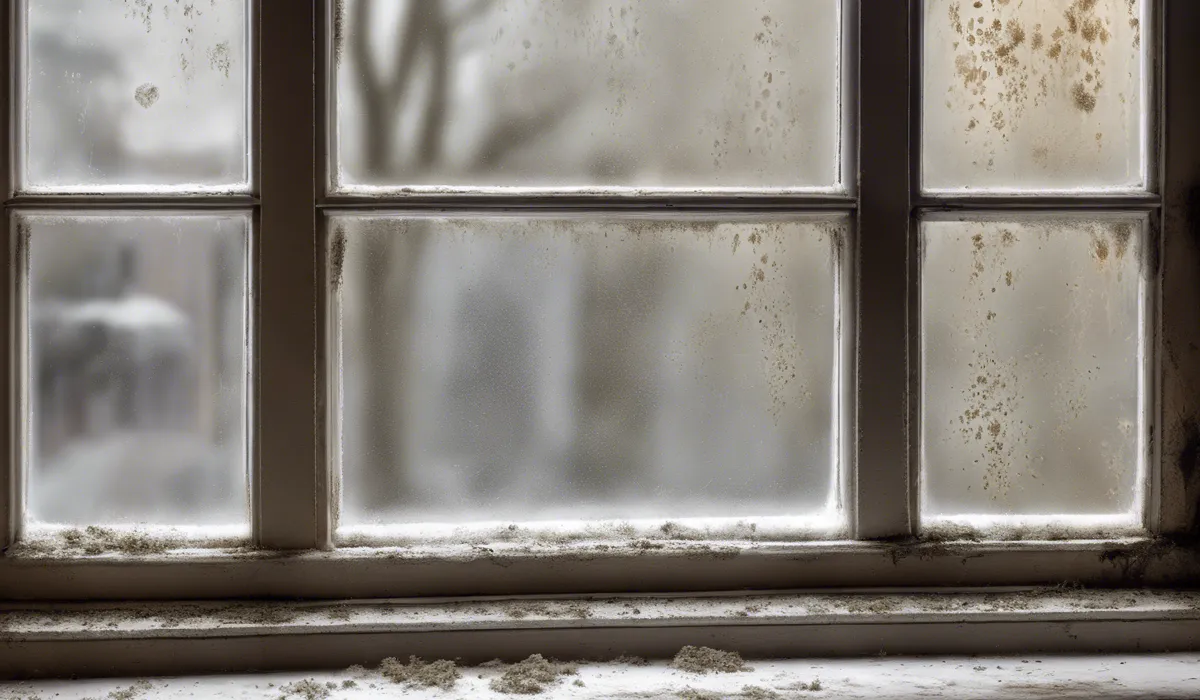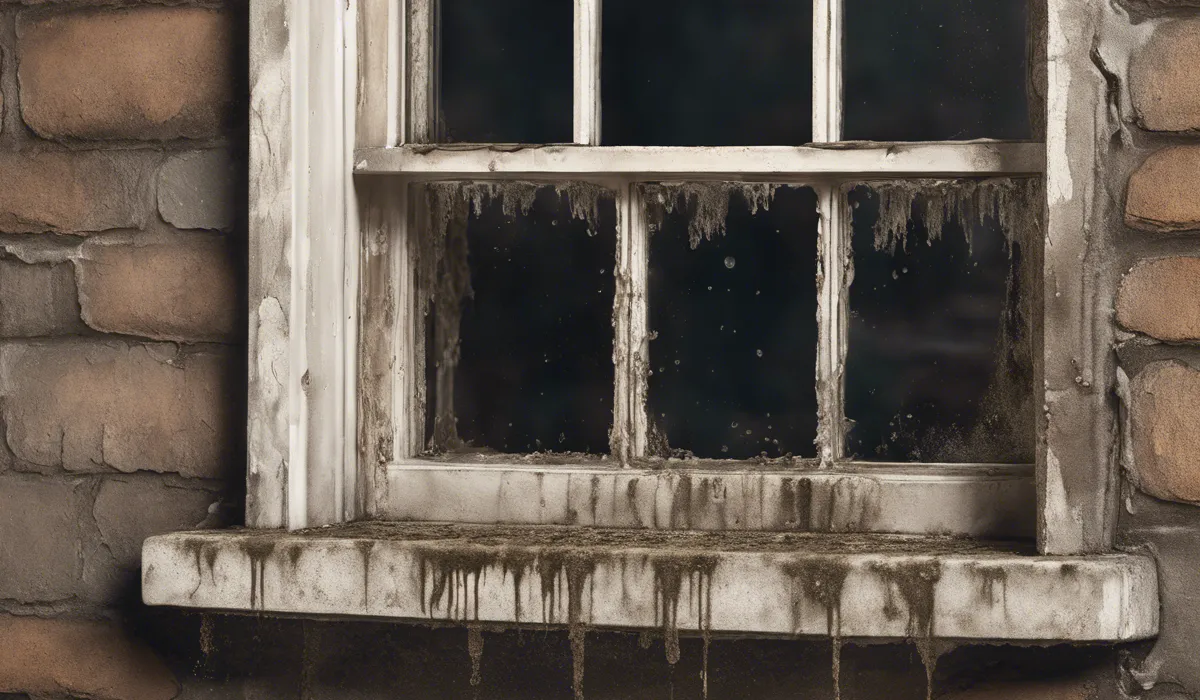Mold grows on window sills primarily due to moisture accumulation. Windows often have condensation from temperature differences, and if the area is not well-ventilated, the dampness persists, creating an ideal environment for mold. Dust and organic material on sills can also nourish mold growth.
Causes of Mold Growth on Window Sills

Presence of Moisture and Condensation
Mold thrives in moist environments, and window sills are often the perfect spot for this unwelcome guest.
The primary culprit for mold on window sills is the presence of moisture and condensation.
Temperature differences between the indoor and outdoor environment can cause water to condense on window surfaces.
In cooler months, warm indoor air collides with the cold window glass, leading to droplets of water that settle on the sills. Conversely, during warm weather, the opposite can happen with cool indoor air.
Seasonal changes also play a significant role in mold growth. The fluctuating temperatures and humidity levels throughout the year can increase the risk of condensation.
During winter and rainy seasons, the increased moisture can contribute to a mold-friendly environment if not properly managed.
Organic Material and Dust Accumulation
Dust and dirt are more than just unsightly; they are also feasts for mold spores. Window sills can collect organic material and dust, which contain nutrients that molds require for growth. Regular cleaning is essential to remove this potential food source for mold.
Indoor plants are another factor that can influence mold growth on window sills. Potting soil and decaying leaves are rich in organic matter, which is an ideal breeding ground for mold.
Plants placed on or near window sills can inadvertently contribute to a mold problem if not maintained properly.
Poor Ventilation and High Humidity Levels
Good air circulation is crucial for preventing mold. Stagnant air can lead to high humidity levels, which mold spores love.
Areas with poor ventilation, such as some window sills, can become hotspots for mold growth.
Everyday activities, such as showering, cooking, and even breathing, add moisture to the air.
Without adequate ventilation to remove this humid air, moisture can settle on cooler surfaces like window sills, creating an environment where mold can flourish.
Health Risks and Impacts of Mold

Allergic Reactions and Respiratory Issues
Mold on window sills is not only a cosmetic issue but also a health hazard. Exposure to mold can lead to allergic reactions and respiratory problems.
Common symptoms include sneezing, coughing, and itchy eyes, particularly in individuals with mold sensitivities.
Over time, continuous exposure to mold can exacerbate asthma and other chronic respiratory conditions.
For those with weakened immune systems or pre-existing lung conditions, the risks are even greater.
It’s crucial for sensitive individuals to avoid environments where mold is present to prevent long-term health complications.
Structural Damage to Property
Mold doesn’t stop at health risks; it can also cause structural damage. Over time, mold can break down the materials that make up your window sills and frames, leading to wood rot, damaged drywall, and peeling paint.
If not addressed, these issues can become extensive, requiring significant repairs.
Untreated mold will continue to grow and spread, potentially affecting larger areas of your property.
It’s essential to tackle mold problems promptly to avoid this escalation and maintain the integrity of your home.
Prevention and Remediation Strategies

Regular Cleaning and Maintenance
One of the simplest yet most effective ways to prevent mold on window sills is through regular cleaning and maintenance.
By routinely wiping down window sills and removing any visible moisture, homeowners can reduce the chances of mold taking hold.
When cleaning window sills, it’s recommended to use a solution of water and white vinegar, which can help kill spores and prevent future growth.
For more stubborn mold, specialized cleaning agents may be necessary.
Improving Air Circulation and Reducing Humidity
Enhancing ventilation is key to controlling mold growth. Opening windows to allow fresh air to circulate can help reduce humidity levels indoors.
Additionally, exhaust fans in bathrooms and kitchens can expel moist air outside, keeping window sills dryer.
For those living in particularly humid climates, dehumidifiers and air conditioners can be valuable tools in maintaining a mold-resistant environment.
By keeping indoor humidity levels between 30-50%, mold growth can be significantly curtailed.
Professional Mold Assessment and Removal
While many mold issues can be addressed with DIY methods, sometimes the problem requires professional intervention.
If mold on your window sills persists despite your best efforts, it’s time to seek professional help.
Professional mold remediation involves assessing the extent of the mold problem and implementing strategies to not only remove the existing mold but also prevent it from returning.
This process often includes the use of industrial-grade equipment and solutions that are not available to the general public.
FAQs About Mold Growth on Window Sills
Why does mold tend to grow on window sills?
Mold grows on window sills mainly due to the accumulation of moisture from condensation, often exacerbated by poor ventilation, which allows the dampness to persist and creates an ideal environment for mold.
How does temperature difference contribute to mold growth on window sills?
Temperature differences between the inside and outside can lead to condensation on windows, providing the moisture that mold needs to grow.
Can dust on window sills contribute to mold growth?
Yes, dust and organic material on window sills can nourish mold, giving it the nutrients it needs to thrive alongside moisture.
Is ventilation important for preventing mold on window sills?
Proper ventilation is crucial as it helps to dry out any condensation and reduce the damp environment that mold requires to grow.
What can be done to prevent mold from growing on window sills?
To prevent mold growth, it’s important to reduce moisture by improving ventilation, using dehumidifiers, or regularly wiping down sills to keep them dry.
Final Thoughts
Mold thrives on window sills as they often become moist from condensation linked to temperature disparities.
This moisture, coupled with poor ventilation, allows the dampness to linger, fostering the perfect conditions for mold to grow.
Additionally, the presence of dust and organic materials serves as a food source for mold, further encouraging its presence in these areas.
